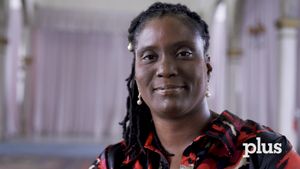Buck is the political donor indicted this month for supplying meth on five counts, including the distribution that lead to the deaths of Moore and Timothy Dean, both Black queer men who Buck victimized.
"The same day Ed Buck sent for my son to fly to L.A. is the same day he died of a meth overdose" Moore's mother, Latisha Nixon, said.
Unfortunately, Moore and Dean aren't Buck's only victims, and Buck's actions aren't an anomaly. There's a rash of sexual predators targeting young Black LBGTQ men, largely through dating apps designed for gay men and sex work. This is contributing to a publicly invisible epidemic plaguing our community, which I believe is rooted in app technology, a lack of inclusiveness -- and feelings these men often have of being viewed as valueless and disposable to society.
This mindset is comprehended and perpetuated by white predators using wealth as barter for those who have nothing.
Crystal meth addiction in Black and Brown neighborhoods is an epidemic we have to acknowledge as a community and fight, before it contributes to more deaths and lost lives, and to the spread of diseases like HIV.
In late August 2017, I interviewed Latisha Nixon for my film, parTy boi, black diamonds in Ice castles, a documentary about the meth epidemic in young Black and Brown LBGTQ communities. During our time together, Nixon said that she was having trouble getting the media to cover the story one month after her son died. She attributed the lack of interest in the heartbreaking story to Buck's political influence. "I just want people to know about what happened to my son, so it doesn't happen to another mother and her child," she said.
I was inspired to create the film after several close friends, all gay men of African descent, like me, overdosed on methamphetamine (aka Tina); some died. I believe a lot of addiction stems from isolation. Queer men of color often find solace in sex and all associated outlets like sex parties and hookup apps, which can be a gateway to meth exposure.
When some people think of the crystal meth epidemic, they envision poor white jobless folks out in former factory or farm towns. On the contrary, meth has become a common and persistent problem among queer Black and Brown communities in New York City, along with urban areas across the country.
It is no longer the inexpensive "dirty meth" we associate with poor white midwestern kids in trailers who mixed it with common household ingredients like Draino. It is purer and often accompanied with liquid GHB (Gamma Hydroxybutyric acid), an anesthetic applied before surgery -- which can be used to equalize pure meth, but also can be utilized as a kind of a date rape drug.
Predators are adding liquid GHB and crushed up meth inside of lube prior to sex. They are also lacing marijuana before giving it to victims to consume so that they become addicted or to induce them into a state of psychosis. Like Buck, predators often groom desperate Black gay youth and young adults for prostitution or use it as a lurid tool for fetishizing Black men.
This type of predator perpetuates and/or exploits the crystal meth epidemic that is plaguing our community. Unlike the opioid epidemic which became labeled as a national crisis after it started affecting white middle class households, the meth epidemic within our community has largely been ignored.
Of the 120 people I interviewed for the documentary, over 80 said that their same-sex partner who also worked as a sex worker for wealthy white clients introduced them to the drug. Their partners were usually offered the drug by "Johns" to party and play (PNP), which spurred them to mutually partake in meth use for more money. Ultimately, they became hooked on the drug. They would oftentimes introduce the drug to their communities with no form of harm reduction knowledge. Then we began to see a ripple effect. Meth is currently trending so much within Black gay enclaves that white "Johns" are no longer needed.
Meth addiction is so prevalent, that Black and Brown dealers are circulating Tina within their own demographics, causing total destruction within a generation of queer Black and Brown men.
"Mom I don't know what to do, all my friends are smoking meth" -Latisha Nixon quoting her son.
When Nixon and I met, we initially bonded over what it was like to be a "meth virgin," to have no experience with meth and then witness a loved one in the throes of this drug.
I personally became involved with the topic when a friend of mine named Jay called me on the phone and asked, "Mike, can you help me? I haven't eaten in three days." I hadn't seen Jay in about a year, and when I met him on Rockaway Avenue, I was shocked to see how he'd changed. He was a shell of the person I knew, with protruding facial bones and big dark circles under his eyes that made him look extremely emaciated.
We sat at the Chinese restaurant as he picked at his General Tso's chicken. Later in my house, Jay told me how he became addicted to meth. Prior to this my only knowledge of crystal meth was from watching Breaking Bad. I also associated the drug with rural white America. I saw my friend's condition and remembered some of the taglines I witnessed from being on dating apps like Grinder, BGC and A4A, but I didn't know the extent of his problem.
Later, I found a treatment center in the phone book, and the organization sent a van to pick him up. By the time they arrived, my friend had returned to his apartment, purportedly to get his insurance card. I never saw him again. I have since witnessed this scene multiple times. When an individual is addicted to meth this way, they lose sight of themselves. It is a terrible thing to watch.
This new crystal meth epidemic within queer Black millennial spaces is reminiscent of the crack era of the late 1980s and early 1990s. During those years, the Black church played a pivotal role in helping to scourge crack from the communities. Today, I believe the Black church tends to dissociate from LGBTQ movements and communities, and hence has not stepped up to help with this problem.
Just as back then, meth addiction contributes to HIV infection within our communities. A disproportionate number of Black gay men are expected to get an HIV diagnosis within their lifetime, according to statistics by the Center for Disease Control and Prevention. Many health organizations focused on HIV have not accepted the way people addicted to meth may be contributing to the spread of this disease. Once you are addicted, you care less, if at all, about protecting others and yourself. It's almost like saying what's the purpose of advertising PrEP and antiretroviral medications if crystal meth is seeking to undo all advances made in the past six years.
It is time for Black and Latino gay men to start talking about this "dirty little secret" that has been plaguing our communities, and to help everyone regardless of race or socio-economic status feel included. We need involvement from multiple communities as well as celebrities and politicians. It's time to create a rehabilitation center for people specifically dealing with crystal meth addiction that provides 24-hour care, including harm reduction tools.
Ed Buck may have been arrested but there are many other predators like him out there, waiting to take advantage of the vulnerable and uninformed. It's time to develop a spirit of bravery and at this point, a sense of normalcy around tackling meth addiction, depression, isolation, homelessness, HIV/AIDS, and sex work.
Micheal Rice is the director of parTy boi: black diamonds in ice castles. Check out the trailer here, the Facebook page here, and the Instagram page here.




































































Charlie Kirk DID say stoning gay people was the 'perfect law' — and these other heinous quotes